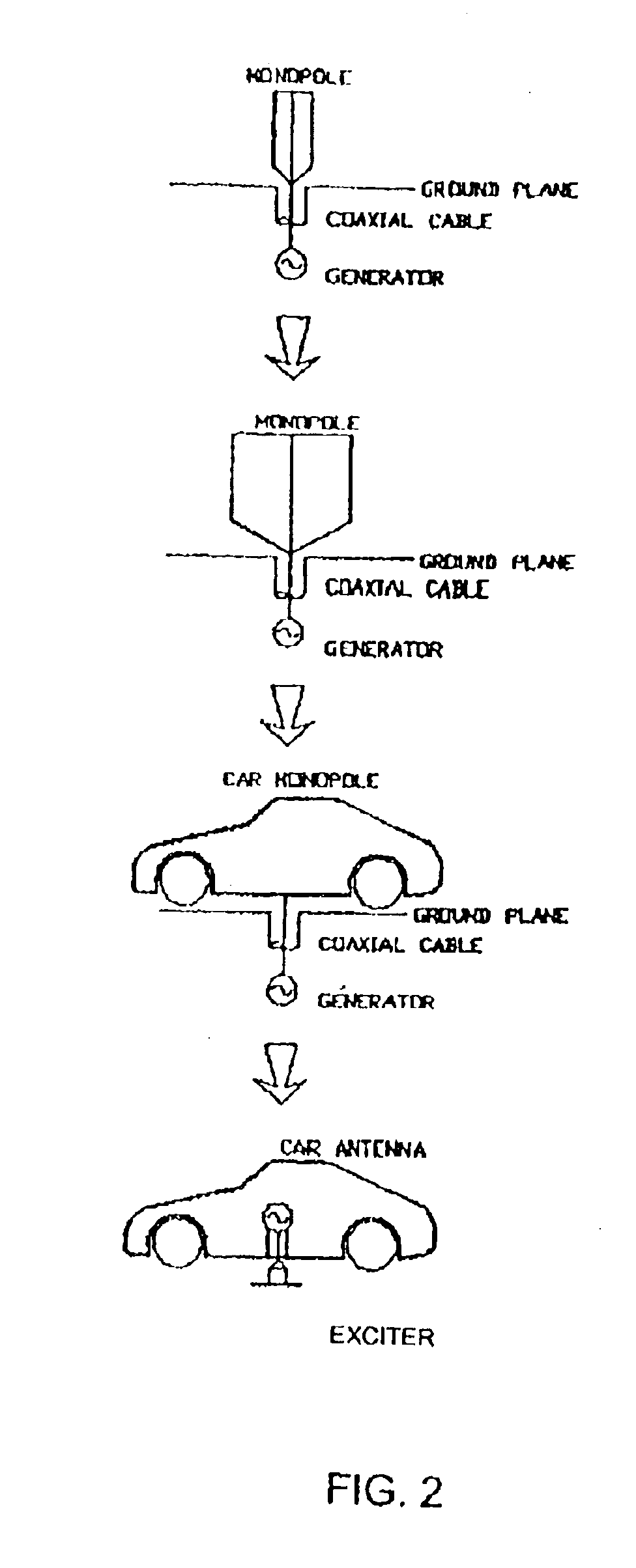Antenna
an exciter and antenna technology, applied in the field of antennas, can solve the problems of destroying the windows along with the antennas, destroying the antennas, and not using discone-type exciters, etc., and achieve the effect of low profil
- Summary
- Abstract
- Description
- Claims
- Application Information
AI Technical Summary
Benefits of technology
Problems solved by technology
Method used
Image
Examples
example 1
[0069]Initial data was first taken on a free space range and included the ground plane shown in FIG. 1. The match of the antenna is shown in FIG. 6. The Voltage Standing Wave Ratio (VSWR) is less than 2:1 from 600 MHz to 1800 MHz. The VSWR is less than 3:1 from 580 MHz to 2 GHz. The azimuth and elevation patterns are shown in FIGS. of 7 through 11. The azimuth patterns are omnidirectional with 1 dB from 800 MHZ to 1.5 GHz and less than 2 dB to 1.9 GHz. The elevation patterns are typical cardiods over the entire band. The 0 degree reference was at the base of the ground plane. The results were considered adequate and the next phase was the testing of an automobile mounted antenna.
example 2
[0070]The FIG. 1 antenna was positioned 9″ from the centerline of the front bumper of an automobile. The measured return loss is shown in FIG. 14 and measured VSWR is shown in FIG. 13. The VSWR is less than 3 to 1 from approximately 620 MHz to 2 GHz. The effect of VSWR on the vehicle is quite small as shown in the comparison of FIG. 6.
[0071]Measured patterns are shown in FIGS. 14 through 16 for frequencies of 850 MHz, 1575 MHz and 1850 MHz and at elevation heights of 1, 3 and 5 feet (the transmitter was located approximately 10 feet away from the vehicle). The 850 MHz frequency generally provided the same response, however, the front lobe was typically 20 dB stronger than the rear lobe. The 1575 MHz frequency provided better coverage for heights of 1-3 feet above the ground and 10 feet away, but was reduced at an elevation of 5 feet. At 1575 MHz the front lobe was typically 20 dB stronger than the rear lobe. At 1850 MHz the front lobe was typically 20 dB stronger than the rear lobe ...
example 3
[0072]The relative gains of an analog cell phone stub antenna, GPS stub antenna and PCS stub antenna are shown in FIGS. 18 through 20 compared with the antenna of the present invention. The antenna of the present invention was stronger over most of the region except for the rearward direction. The stub antennas for each unit were located on the console between the driver and passenger seats. The stub antennas were mounted vertically to match the testing antenna polarization. The test range layout is shown in FIG. 21.
PUM
 Login to View More
Login to View More Abstract
Description
Claims
Application Information
 Login to View More
Login to View More - R&D Engineer
- R&D Manager
- IP Professional
- Industry Leading Data Capabilities
- Powerful AI technology
- Patent DNA Extraction
Browse by: Latest US Patents, China's latest patents, Technical Efficacy Thesaurus, Application Domain, Technology Topic, Popular Technical Reports.
© 2024 PatSnap. All rights reserved.Legal|Privacy policy|Modern Slavery Act Transparency Statement|Sitemap|About US| Contact US: help@patsnap.com










